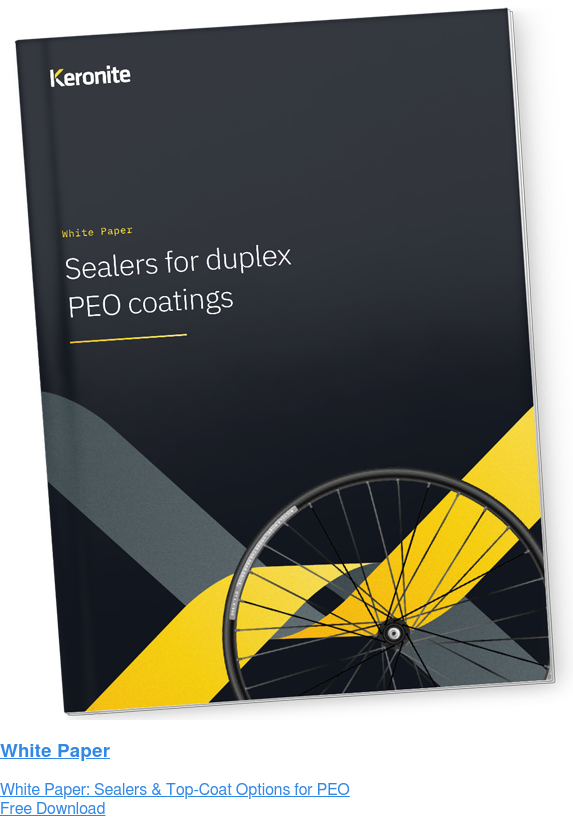Plasma electrolytic oxide (PEO) sealers: reviewing coating performance
11 October 2021New, emerging technologies are pushing new priorities out to materials scientists and researchers. These requirements are making it all-the-more important to find new solutions that further enhance the corrosion, thermal and wear performance of light alloys. Scientists are also finding innovative ways to introduce new characteristics into light alloys – as part of duplex surface coating technologies.
Plasma electrolytic oxidation (PEO) coatings can be used to uniquely enhance the protective properties of light metals. These thin-film coatings improve corrosion and wear resistance and increase hardness. Yet adding a secondary sealer coating (as part of a duplex coating solution) can further enhance coating properties, enabling PEO’s use in a wide range of applications.
PEO is an advanced surface coating technology for aluminium, magnesium, titanium and other light alloys. The process involves immersing components in an electrolyte bath, which can be tailored to create desired coating characteristics, as can the electrical regime employed.
One of the most notable features of the coatings are their complex microstructure, which gives it its strength, while also being porous. The porosity of the coating enables PEO to act as a highly adhesive ‘key’ for a variety of sealing materials and duplex coatings. This means that, in addition to high levels of corrosion resistance, wear resistance and hardness, PEO coatings can incorporate other properties, depending on the combination of the PEO coating and sealer. This can introduce high-performing coating properties such as high dielectric breakdown strength, thermal dissipation and even anti-microbial traits.
Duplex PEO coating systems – PEO combined with organic and silicone-based sealers – can be used for components that need to withstand extremes of temperature, pressure, chemical exposure or other hostile environments. This allows light metal components to be used in place of heavier alternatives, reducing the weight of components while elongating their working life.
PEO Sealers: Choosing the right one
Many traditional surface coating methods, such as epoxy or polyurethane paints, require surface pre-treatment before application. This usually includes cleaning, degreasing, and preparing the surface to increase roughness and ensure strong adhesion to the metal. Primers are also used to improve adhesion between the metal surface and functional coating.
PEO coatings can act as the primary layer, with secondary sealers applied on top, thereby creating a duplex coating system. Interfacial adhesion is excellent, thanks to the crystalline structure grown in-situ at the metal surface, and the porous outer layer of PEO coating which the sealer adheres to.
The porosity of a PEO coating can be tailored to create the best possible conditions for adhesion, depending on the secondary sealer. Extensive testing has been carried out in Keronite’s development laboratories to demonstrate coating performance using different combinations of PEO coatings and sealers. Each coating combination creates unique surface properties, suitable for various applications:
1. Epoxy sealers
Epoxy-PEO coating combinations can be used for corrosion protection and chemical resistance in industries such as aerospace or oil & gas. Epoxy sealers are usually spray-applied, and their high crosslink density provides excellent protection for the metal substrate. However, epoxy coatings have low abrasion resistance and can become brittle when exposed to high temperatures.
2. Polyurethane (PU) coatings
PU coatings are often used as a topcoat in various applications. They can be tailored to create a range of different colours and aesthetic finishes, which are stable on exposure to UV-light and provide good chemical resistance. These can be applied via conventional spray techniques or electrophoretic coating (E-coating). E-coating is similar to the PEO coating method; the component is suspended in an electrolyte bath and a voltage is passed through. This quickly creates a uniform coating layer which may require subsequent curing steps.
3. Fluorocarbon-based sealers
Fluorocarbon-based sealers can be used to create a chemically resistant, easy-clean finish thanks to their high lubricity. Polymer coatings such as polytetrafluroethylene (PTFE) can be doped with metal oxide particles to create high microhardness and a low friction coefficient. This type of sealer is ideal in manufacturing environments where cleanliness is key, such as semiconductor fabrication.
4. Silicon-based coatings
Silicon-based sealers form chemical bonds with the free hydroxyls on the PEO coating underneath. This creates excellent substrate adhesion, which is combined with the flexibility, heat resistance, and chemical resistance of a typical silicon coating. Organic functionality can be added to the polymer precursor to alter surface properties or improve durability and flexibility.
5. Sol-gel coatings
Sol-gel sealers can be used to create anti-corrosive coatings. Benchtop studies with sol-gel-PEO coatings show good penetration of the sol into the porous PEO layer. This creates an effective barrier and significantly reduces the corrosion current density, protecting the metal underneath.
Each of these sealers has unique characteristics that perform well under certain conditions. As more industries look to replace steel or cast-iron components with light metals, developing coatings for these alloys becomes essential.
Keronite’s team of materials scientists have carried out extensive research into duplex coating systems, to further enhance the performance of our highly versatile PEO coatings.
For more information about sealers and duplex coating systems with a PEO primary coat, download our whitepaper, “Sealers for Duplex PEO Systems” or speak to one of our scientists to learn more about how these systems could solve your surface technology challenges.

 Keronite is now part of the CWST engineered coatings business.
Keronite is now part of the CWST engineered coatings business.